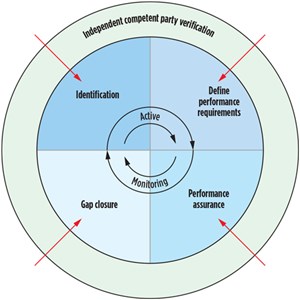Energy issues
Just when you thought Macondo was behind us, a new round of analyses and publications emerges. The first is the Investigation Report by the U.S. Chemical Safety Board (CSB) entitled, Drilling Rig Explosion and Fire at the Macondo Well, released in April. The second is a newly published book by Earl Boebert and James M. Blossom entitled, Deepwater Horizon: A Systems Analysis of the Macondo Disaster.
In the latter publication, a number of critical systems are identified and or implied. These include both technical and organization systems. BP, for example, can be viewed as a system, as can Transocean. Moving down one layer, within BP there existed the onshore engineering system and the rig site management system. Further down, one would encounter a BP safety and well control system that did not match the Transocean safety and well control system.

The crux of the argument made by Boebert and Blossom is that these systems did not interact well. There was, they argue, no overarching safety management system with buy-in from all parties, either within the companies or between the companies. For example, “according to Transocean policy, the Offshore Installation Manager (OIM) was in charge when the Horizon was latched up and acting like a drilling rig, and the master was in command when the Horizon was moving and acting like a seagoing vessel—or in a state of emergency.”
The Republic of the Marshall Islands allowed this division of responsibility, owing to a “clerical error” that had Horizon categorized as an anchored, stationary rig. The result was uncertainty about who was in charge after the blowout.” At all levels, systems were endemic. “The drilling side was a confederation of eight different corporations supported by an ad hoc, distributed assemblage of equipment from multiple vendors.” This is standard on a rig and is not the problem. Rather, according to Boebert and Blossom, the problem is the lack of necessary interaction between many of these groups, both offshore and onshore.
The report by the CSB addresses many of the same systemic issues. They note that the “lack of, or minimal, detail provided by the operator in written work plans, places a heavy reliance on the skills, knowledge and experience of the drilling contractor which may not be sufficient for the task.” In other words, the BP system fails to interact correctly with the Transocean system. That disengagement between systems moved farther down the chain at Macondo.
“On the day of the April 20 tragedy, no effective safeguards were in place to eliminate or minimize the consequences of a process safety incident. The safeguards (or barriers) intended to prevent such a disaster were not properly constructed, tested, or maintained, or they had been removed. The management systems intended to ensure the required functionality, availability, and reliability of these safety-critical barriers were inadequate. Ultimately, the barriers meant to prevent, mitigate or control a blowout failed on the day of the accident.” Those failures, according to both publications, occurred across many of the safety-critical systems, and especially across the BOP and riser system, as illustrated below.
The systems oriented discussion in Deepwater Horizon: A Systems Analysis of the Macondo Disaster is, in some respects, an interesting departure from other analyses of the disaster. It makes sense and, more importantly, it doesn’t dismiss the role that human factors (failures) played in the incident. I would recommend it. The CSB analysis is also on target, hinting at systems failures in a larger evaluation of the causes of the disaster. Based on nearly one million documents, numerous interviews, investigation and litigation documents and meetings with regulators, industry and workforce representatives in the U.S., UK, Norway, Canada, Australia and Brazil, in addition to conducting two public hearings, it is a lengthy (nearly 500 pages) tome. It is available on the web at http://www.csb.gov/macondo-blowout-and-explosion/.
It is hard to say how long the Macondo incident will haunt the industry. With the progress of technology, one would think that the chances of another such incident would decline. But, as these two publications point out, if the technological systems don’t have proper safety management, if the systems are not aligned from the lowest level to the highest, it is just a matter of time before we are gasping in disbelief again. ![]()

- Coiled tubing drilling’s role in the energy transition (March 2024)
- Advancing offshore decarbonization through electrification of FPSOs (March 2024)
- Subsea technology- Corrosion monitoring: From failure to success (February 2024)
- Digital tool kit enhances real-time decision-making to improve drilling efficiency and performance (February 2024)
- E&P outside the U.S. maintains a disciplined pace (February 2024)
- Prices and governmental policies combine to stymie Canadian upstream growth (February 2024)


